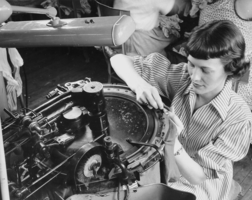 | Back to e-WV
| Back to e-WV
 The West Virginia Encyclopedia
The West Virginia Encyclopedia
 | Back to e-WV
| Back to e-WV
 The West Virginia Encyclopedia
The West Virginia Encyclopedia

Interwoven Mills, a maker of men’s hosiery, was the largest employer in Martinsburg for several decades. It had its start in 1890–91, when entrepreneurs from Philadelphia and New Brunswick, New Jersey, invested the money to build the country’s first electric-powered mill. The company went through a number of name changes, beginning as Middlesex Knitting Company, then becoming Kilbourn Knitting Mill and later Interwoven Hosiery, among other names. Local people most often referred to it as the Kilbourn Mill.
By the 19th century’s end, Interwoven had outgrown its original building and moved to a permanent site on the Baltimore & Ohio Railroad. By the end of 1906, the company had 2,000 domestic accounts which included some of the country’s largest retail businesses, and was shipping goods overseas; salesmen also sold Interwoven products door-to-door. By 1921, Interwoven had opened branch plants in Hagerstown, Maryland; Chambersburg, Pennsylvania; and Berkeley Springs.
Interwoven prospered until the 1929 stock market crash and ensuing Depression. Like many factories around the country, Interwoven was confronted by organized labor during the 1930s and 1940s. Interwoven workers took part in the Textile Workers of America’s nationwide strike in 1934. Approximately 80 percent of the employees walked out, forcing the company to operate with a skeleton crew. Despite the fact that the Interwoven strikers remained out beyond the end of the general strike, they did not settle any of their grievances. These unresolved issues contributed to a 1941 strike.
During World War II, Interwoven manufactured socks for army and navy personnel. Beginning in the 1950s, the company suffered from international and local competition. Employment dropped from more than 3,000 in the early 1950s to 900 in 1960. Ownership changed in 1962. Interwoven decided to move most of its operation to North Carolina, and Kayser-Roth, Inc., purchased the Martinsburg operation. Kayser-Roth closed the Martinsburg complex in February 1976, bringing an important chapter in the city’s industrial history to an end.
Written by Jerra Jenrette
Rice, Otis K. & Stephen W. Brown. West Virginia: A History. Lexington: University Press of Kentucky, 1993.
Johnston, Wilbur. Weaving a Common Thread: A History of the Woolen Industry in the Top of the Shenandoah Valley. Winchester: Winchester- Frederick County Historical Society, 1990.
Jenrette, Jerra. "'There's No Damn Reason for It - It's Just our Policy': Labor-Management Conflict in Martinsburg, West Virginia's Textile and Garment Industries." Ph.D. diss., West Virginia University, 1996.